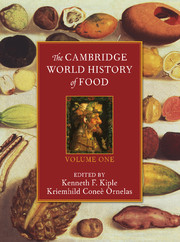Book contents
- Frontmatter
- Introduction
- Part I Determining What Our Ancestors Ate
- Part II Staple Foods: Domesticated Plants and Animals
- II.A Grains
- II.A.1 Amaranth
- II.A.2 Barley
- II.A.3 Buckwheat
- II.A.4 Maize
- II.A.5 Millets
- II.A.6 Oat
- II.A.7 Rice
- II.A.8 Rye
- II.A.9 Sorghum
- II.A.10 Wheat
- II.B Roots, Tubers, and Other Starchy Staples
- II.C Important Vegetable Supplements
- II.D Staple Nuts
- II.E Animal, Marine, and Vegetable Oils
- II.F Trading in Tastes
- II.G Important Foods from Animal Sources
- Part III Dietary Liquids
- Part IV The Nutrients – Deficiencies, Surfeits, and Food-Related Disorders
- References
II.A.3 - Buckwheat
from II.A - Grains
Published online by Cambridge University Press: 28 March 2008
- Frontmatter
- Introduction
- Part I Determining What Our Ancestors Ate
- Part II Staple Foods: Domesticated Plants and Animals
- II.A Grains
- II.A.1 Amaranth
- II.A.2 Barley
- II.A.3 Buckwheat
- II.A.4 Maize
- II.A.5 Millets
- II.A.6 Oat
- II.A.7 Rice
- II.A.8 Rye
- II.A.9 Sorghum
- II.A.10 Wheat
- II.B Roots, Tubers, and Other Starchy Staples
- II.C Important Vegetable Supplements
- II.D Staple Nuts
- II.E Animal, Marine, and Vegetable Oils
- II.F Trading in Tastes
- II.G Important Foods from Animal Sources
- Part III Dietary Liquids
- Part IV The Nutrients – Deficiencies, Surfeits, and Food-Related Disorders
- References
Summary
Buckwheat (Fagopyrum esculentum Möench) is a crop commonly grown for its black or gray triangular seeds. It can also be grown as a green manure crop, a companion crop, a cover crop, as a source of buckwheat honey (often for the benefit of bees), and as a pharmaceutical plant yielding rutin, which is used in the treatment of capillary fragility. Buckwheat belongs to the Polygonaceae family (as do sorrel and rhubarb). Whereas cereals such as wheat, maize, and rice belong to the grass family, buckwheat is not a true cereal. Its grain is a dry fruit.
Buckwheat is believed to be native to Manchuria and Siberia and, reportedly, was cultivated in China by at least 1000 B.C. However, fragments of the grain have been recovered from Japanese sites dating from between 3500 and 5000 B.C., suggesting a much earlier date for the grain’s cultivation. It was an important crop in Japan and reached Europe through Turkey and Russia during the fourteenth and fifteenth centuries A.D., although legend would have it entering Europe much earlier with the returning Crusaders. Buckwheat was introduced into North America in the seventeenth century by the Dutch, and it is said that its name derives from the Dutch word bochweit (meaning “beech wheat”), because the plant’s triangular fruits resemble beechnuts. In German the name for beech is Buche, and for buckwheat, Buchweizen. Buckwheat has a nutty flavor and, when roasted (kasha), a very strong one. It is a hardy plant that grew in Europe where other grains did not and, thus, supplied peasants in such areas with porridge and pancakes.
- Type
- Chapter
- Information
- The Cambridge World History of Food , pp. 90 - 97Publisher: Cambridge University PressPrint publication year: 2000
References
- 1
- Cited by

